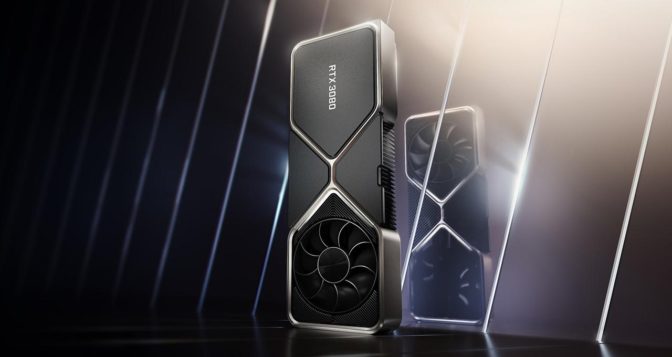This week NVIDIA announced its new NVIDIA GeForce RTX 30 Series graphic cards. The new cards are powered by Ampere and feature faster 2nd gen Ray Tracing Cores, faster 3rd gen Tensor Cores, and new streaming multiprocessors. These new cards are all aimed at gamers and creators and are said to bring better visuals, faster frame rates, and AI Acceleration.

NVIDIA started out with its new Ampere architecture in the data center. While it came out with lots of cool announcements, it is now moving this power into consumer devices with its GeForce RTX 30 Series. This series comes with several cool new features including the first gaming-class graphics cards with up to 24GB of GDDR6X VRAM, the first GPUs with HDMI 2.1 supports, and the first discrete GPUs with AV1 codec support. The new series comes with several of the company’s technologies for better play and creation including:
- NVIDIA Reflex reduces system latency, providing split-second PC gaming responsiveness
- NVIDIA Broadcast turns any room into a home broadcast studio with AI-enhanced video and voice comms
- Updates to NVIDIA DLSS make 8K HDR gaming a reality on the GeForce RTX 3090 graphics card
- NVIDIA Studio enhancements make creative applications run faster
GeForce RTX 30 Series Key Specifications
| Architecture Name | Ampere |
| Streaming Multiprocessors | 2x FP32 |
| Ray Tracing Cores | Gen 2 |
| Tensor Cores (AI) | Gen 3 |
| Memory | Up to 24 GB GDDR6X |
| VR Ready | Yes |
| PCIe | Gen 4 |
| Video Outputs | HDMI 2.1, DisplayPort 1.4a |
NVIDIA partners with several companies to make custom cards; they are also releasing their own “Founders Edition” GeForce GPU. This special edition has a unique design for cooling with up to two mounted fans, and it just looks cool. According to NVIDIA, as heat is drawn away from components into the hybrid vapor chamber, it is efficiently distributed across the length of the card and throughout the massive aluminum fin stack. The left fan pushes air heated by the fin stack out through extra-large GPU bracket vents, while the right fan draws the air towards the top chassis exhaust. Adding fan(S) to a GPU can be demanding as the PCB is typically the length of the card. Here, NVIDIA made a smaller PCB but still packs much more power in.
It wouldn’t be an update to an NVIDIA product without a performance boost. New hardware includes the aforementioned Ampere. The heart of performance in NVIDIA GPUs is Streaming Multiprocessors (SMs). The NVIDIA Ampere Streaming Multiprocessors are the company’s most advanced with the promise of the best performance. The new SMs offer 2x FP32 throughput compared to the previous generation. The new SMs also deliver more performance per watt and leverage PCIe 4.0. This means more performance than before without overclocking.
NVIDIA introduced ray tracing a few years back with its RTX GPUs and RT Cores. The GeForce RTX 30 Series GPUs comes with 2nd generation RT Core with twice the throughput. Rasterized and ray-traced games are further enhanced with the deep learning neural network, powered by dedicated AI processors called Tensor Cores, NVIDIA DLSS. This can boost frame rates while maintaining crisp, clear image quality even in complicated games.
With the new GPU series comes new GDDR6X memory from Micron. Both the RTX 3090 and GeForce RTX 3080 leverage GDDR6X memory. The companies state that this memory ensures the GPU’s compute cores and other components receive a constant stream of data, rather than stalling while they wait, maximizing efficiency and performance.
Everything so far sounds good until latency introduces a big fat bag of lag into your gaming. NVIDIA is working around this with its suite of GPU, G-SYNC display, and software technologies that allow gamers to measure and optimize system latency, NVIDIA Reflex. Lower latency means better responsiveness and will be coming to games including Apex Legends, Call of Duty: Black Ops Cold War, Call of Duty: Modern Warfare, Call of Duty: Warzone, Destiny 2, Fortnite, and Valorant.
Availability
The NVIDIA GeForce RTX 3090 and 3080 will be available this month for $1499 and $699 respectively. The NVIDIA GeForce RTX 3070 is expected next month and will be priced at $499. Several partners will have custom cards along with NVIDIA Founders Edition models.




 Amazon
Amazon